Spatial–Temporal Variations and the Driving Factors of Vegetation Coverage in the Loess Hilly and Gully Region of China
Abstract
:1. Introduction
2. Materials and Methods
2.1. Study Area
2.2. Data
2.3. Data Analysis Methods
2.3.1. Sen + MK Test
2.3.2. Hurst Index
2.3.3. Geodetector Model
2.3.4. Selection and Pre-Processing of Indicators
3. Results and Analysis
3.1. Spatial–Temporal Variation of NDVI
3.2. Past NDVI Trends
3.3. Future NDVI Trends
3.4. Temporal Variation of Driving Factors
3.5. Effects of Different Factors on the Spatial Variation of NDVI
3.5.1. Factor Detection
3.5.2. Interaction Detection
3.5.3. Significant Differences among NDVI Drivers
3.5.4. Appropriate Range or Type of Each NDVI Driver
4. Discussion
4.1. Explanation for NDVI Spatial Distribution
4.2. Analysis of NDVI Drivers
4.2.1. Analysis of Land Use Drivers on NDVI
4.2.2. Analysis of Topography Drivers on NDVI
4.2.3. Analysis of Climatic and Other Environmental Drivers on NDVI
5. Conclusions
- The NDVI showed a fluctuating upward trend, with a rate of 0.0108/year and a multi-year average of 0.542. The NDVI values in 98.56% of the study area increased, whereas only 1.44% declined. The declining NDVI areas are mainly concentrated in the cities of Yulin, Yan’an, and Lvliang, where urban development is relatively rapid.
- The vegetation cover has improved significantly over the last 20 years in 95.14% of the total area, which means that the study area’s ecological reconstruction was effective. However, the percentage of persistent vegetation improvement was relatively low, accounting for 37.36%.
- The Geodetector model results show that annual precipitation and relative humidity were the primary factors among climatic factors leading to vegetation improvement. The influence of elevation is greater than that of slope and aspect among the topographic factors. Vegetation type had significant effects among other environmental factors. For human factors, land use type was the major driver.
- There was a dual-factor and non-linear enhancement interaction between the drivers on NDVI, and the influence of the interaction was greater than the independent. The favorable ranges of annual precipitation, potential evapotranspiration, and relative humidity were 559.4–698.6 mm, 530.6–744.6 mm, and 59%–62%, respectively. The suitable elevation range was 2006–2717 m. The suitable land use type was forest land; the vegetation type was coniferous forest; and the soil type was eluvial soil.
Author Contributions
Funding
Data Availability Statement
Conflicts of Interest
References
- Afuye, G.A.; Kalumba, A.M.; Busayo, E.T.; Orimoloye, I.R. A bibliometric review of vegetation response to climate change. Environ. Sci. Pollut. Res. 2021, 29, 18578–18590. [Google Scholar] [CrossRef]
- Fu, G.; Sun, W.; Li, S.; Zhang, J.; Yu, C.; Shen, Z. Modeling Aboveground Biomass Using MODIS Images and Climatic Data in Grasslands on the Tibetan Plateau. J. Resour. Ecol. 2017, 8, 42–49. [Google Scholar] [CrossRef]
- Gong, Z.; Zhao, S.; Gu, J. Correlation analysis between vegetation coverage and climate drought conditions in North China during 2001–2013. J. Geogr. Sci. 2017, 27, 143–160. [Google Scholar] [CrossRef]
- Faour, G.; Mhawej, M.; Nasrallah, A. Global trends analysis of the main vegetation types throughout the past four decades. Appl. Geogr. 2018, 97, 184–195. [Google Scholar] [CrossRef]
- Mallick, J.; AlMesfer, M.K.; Singh, V.P.; Falqi, I.I.; Singh, C.K.; Alsubih, M.; Kahla, N.B. Evaluating the NDVI–Rainfall Relationship in Bisha Watershed, Saudi Arabia Using Non-Stationary Modeling Technique. Atmosphere 2021, 12, 593. [Google Scholar] [CrossRef]
- Yang, L.; Guan, Q.; Lin, J.; Tian, J.; Tan, Z.; Li, H. Evolution of NDVI secular trends and responses to climate change: A perspective from nonlinearity and nonstationarity characteristics. Remote Sens. Environ. 2021, 254, 112247. [Google Scholar] [CrossRef]
- Chen, X.; Yang, D.; Chen, J.; Cao, X. An improved automated land cover updating approach by integrating with downscaled NDVI time series data. Remote Sens. Lett. 2015, 6, 29–38. [Google Scholar] [CrossRef]
- Peng, W.; Kuang, T.; Tao, S. Quantifying influences of natural factors on vegetation NDVI changes based on geographical detector in Sichuan, western China. J. Clean. Prod. 2019, 233, 353–367. [Google Scholar] [CrossRef]
- Vorovencii, I. Applying the change vector analysis technique to assess the desertification risk in the south-west of Romania in the period 1984–2011. Environ. Monit. Assess. 2017, 189, 524. [Google Scholar] [CrossRef] [PubMed]
- Zhu, L.; Meng, J.; Zhu, L. Applying Geodetector to disentangle the contributions of natural and anthropogenic factors to NDVI variations in the middle reaches of the Heihe River Basin. Ecol. Indic. 2020, 117, 106545. [Google Scholar] [CrossRef]
- Gao, S.; Dong, G.; Jiang, X.; Nie, T.; Yin, H.; Guo, X. Quantification of Natural and Anthropogenic Driving Forces of Vegetation Changes in the Three-River Headwater Region during 1982–2015 Based on Geographical Detector Model. Remote Sens. 2021, 13, 4175. [Google Scholar] [CrossRef]
- Tao, S.; Peng, W.; Xiang, J. Spatiotemporal variations and driving mechanisms of vegetation coverage in the Wumeng Mountainous Area, China. Ecol. Inform. 2022, 70, 101737. [Google Scholar] [CrossRef]
- Ren, Z.; Tian, Z.; Wei, H.; Liu, Y.; Yu, Y. Spatiotemporal evolution and driving mechanisms of vegetation in the Yellow River Basin, China during 2000–2020. Ecol. Indic. 2022, 138, 108832. [Google Scholar] [CrossRef]
- Fu, B.; Wang, S.; Liu, Y.; Liu, J.; Liang, W.; Miao, C. Hydrogeomorphic Ecosystem Responses to Natural and Anthropogenic Changes in the Loess Plateau of China. Annu. Rev. Earth Planet. Sci. 2017, 45, 223–243. [Google Scholar] [CrossRef]
- Fu, B.; Chen, L.; Ma, K.; Zhou, H.; Wang, J. The relationships between land use and soil conditions in the hilly area of the loess plateau in northern Shaanxi, China. Catena 2000, 39, 69–78. [Google Scholar] [CrossRef]
- Wang, X.; Wang, B.; Xu, X.; Liu, T.; Duan, Y.; Zhao, Y. Spatial and temporal variations in surface soil moisture and vegetation cover in the Loess Plateau from 2000 to 2015. Ecol. Indic. 2018, 95, 320–330. [Google Scholar] [CrossRef]
- Zhang, Y.; Jiang, X.; Lei, Y.; Gao, S. The contributions of natural and anthropogenic factors to NDVI variations on the Loess Plateau in China during 2000–2020. Ecol. Indic. 2022, 143, 109342. [Google Scholar] [CrossRef]
- Yang, Y.; Wang, B.; Wang, G.; Li, Z. Ecological regionalization and overview of the Loess Plateau. Acta Ecol. Sin. 2019, 39, 7389–7397. (In Chinese) [Google Scholar] [CrossRef]
- Zuo, Y.; Li, Y.; He, K.; Wen, Y. Temporal and spatial variation characteristics of vegetation coverage and quantitative analysis of its potential driving forces in the Qilian Mountains, China, 2000–2020. Ecol. Indic. 2022, 143, 109429. [Google Scholar] [CrossRef]
- Joshi, N.; Gupta, D.; Suryavanshi, S.; Adamowski, J.; Madramootoo, C.A. Analysis of trends and dominant periodicities in drought variables in India: A wavelet transform based approach. Atmos. Res. 2016, 182, 200–220. [Google Scholar] [CrossRef]
- Chen, J.; Xu, C.; Lin, S.; Wu, Z.; Qiu, R.; Hu, X. Is There Spatial Dependence or Spatial Heterogeneity in the Distribution of Vegetation Greening and Browning in Southeastern China? Forests 2022, 13, 840. [Google Scholar] [CrossRef]
- Zuo, D.; Han, Y.; Xu, Z.; Li, P.; Ban, C. Time-lag effects of climatic change and drought on vegetation dynamics in an alpine river basin of the Tibet Plateau, China. J. Hydrol. 2021, 600, 126532. [Google Scholar] [CrossRef]
- Dinpashoh, Y.; Jhajharia, D.; Fakheri-Fard, A.; Singh, V.P.; Kahya, E. Trends in reference crop evapotranspiration over Iran. J. Hydrol. 2011, 399, 422–433. [Google Scholar] [CrossRef]
- Hou, X.; Wu, T.; Yu, L.; Qian, S. Characteristics of multi-temporal scale variation of vegetation coverage in the Circum Bohai Bay Region, 1999–2009. Acta Ecol. Sin. 2012, 32, 297–304. [Google Scholar] [CrossRef]
- Tong, S.; Lai, Q.; Zhang, J.; Bao, Y.; Lusi, A.; Ma, Q.; Li, X.; Zhang, F. Spatiotemporal drought variability on the Mongolian Plateau from 1980-2014 based on the SPEI-PM, intensity analysis and Hurst exponent. Sci. Total Environ. 2018, 615, 1557–1565. [Google Scholar] [CrossRef] [PubMed]
- Jiang, L.; Guli·Jiapaer; Bao, A.; Guo, H.; Ndayisaba, F. Vegetation dynamics and responses to climate change and human activities in Central Asia. Sci. Total Environ. 2017, 599–600, 967–980. [Google Scholar] [CrossRef] [PubMed]
- Wang, J.; Xu, C. Geodetector: Principle and prospective. Acta Geogr. Sin. 2017, 72, 116–134. (In Chinese) [Google Scholar] [CrossRef]
- Chen, T.; Xia, J.; Zou, L.; Hong, S. Quantifying the Influences of Natural Factors and Human Activities on NDVI Changes in the Hanjiang River Basin, China. Remote Sens. 2020, 12, 3780. [Google Scholar] [CrossRef]
- Wang, G.; Peng, W. Quantifying spatiotemporal dynamics of vegetation and its differentiation mechanism based on geographical detector. Environ. Sci. Pollut. Res. Int. 2022, 29, 32016–32031. [Google Scholar] [CrossRef] [PubMed]
- Dong, Y.; Yin, D.; Li, X.; Huang, J.; Su, W.; Li, X.; Wang, H. Spatial–Temporal Evolution of Vegetation NDVI in Association with Climatic, Environmental and Anthropogenic Factors in the Loess Plateau, China during 2000–2015: Quantitative Analysis Based on Geographical Detector Model. Remote Sens. 2021, 13, 4380. [Google Scholar] [CrossRef]
- Li, P.; Qian, H.; Wu, J. Environment: Accelerate research on land creation. Nature 2014, 510, 29–31. [Google Scholar] [CrossRef] [Green Version]
- Wang, J.; Wang, K.; Zhang, M.; Zhang, C. Impacts of climate change and human activities on vegetation cover in hilly southern China. Ecol. Eng. 2015, 81, 451–461. [Google Scholar] [CrossRef]
- Fu, W.; Lü, Y.; Harris, P.; Comber, A.; Wu, L. Peri-urbanization may vary with vegetation restoration: A large scale regional analysis. Urban For. Urban Green. 2018, 29, 77–87. [Google Scholar] [CrossRef] [Green Version]
- Huang, Z.L.; Chen, L.D.; Fu, B.J.; Lu, Y.H.; Huang, Y.L.; Gong, J. The relative efficiency of four representative cropland conversions in reducing water erosion: Evidence from long-term plots in the Loess hilly area, China. Land Degrad. Dev. 2006, 17, 615–627. [Google Scholar] [CrossRef]
- Yuan, J.; Xu, Y.; Xiang, J.; Wu, L.; Wang, D. Spatiotemporal variation of vegetation coverage and its associated influence factor analysis in the Yangtze River Delta, eastern China. Environ. Sci. Pollut. Res. Int. 2019, 26, 32866–32879. [Google Scholar] [CrossRef] [PubMed]
- Feng, J.; Dong, B.; Qin, T.; Liu, S.; Zhang, J.; Gong, X. Temporal and Spatial Variation Characteristics of NDVI and Its Relationship with Environmental Factors in Huangshui River Basin from 2000 to 2018. Pol. J. Environ. Stud. 2021, 30, 3043–3063. [Google Scholar] [CrossRef]
- Zhao, T.; Bai, H.; Deng, C.; Meng, Q.; Guo, S.; Qi, G. Topographic differentiation effect on vegetation cover in the Qinling Mountainsfrom 2000 to 2016. Acta Ecol. Sin. 2019, 39, 4499–4509. (In Chinese) [Google Scholar] [CrossRef]
- Xin, Z.; Xu, J.; Zheng, W. Spatiotemporal variations of vegetation cover on the Chinese Loess Plateau (1981–2006): Impacts of climate changes and human activities. Sci. China Ser. D Earth Sci. 2008, 51, 67–78. [Google Scholar] [CrossRef]
- Zhao, X.; Tan, K.; Zhao, S.; Fang, J. Changing climate affects vegetation growth in the arid region of the northwestern China. J. Arid Environ. 2011, 75, 946–952. [Google Scholar] [CrossRef]
- Xie, B.; Jia, X.; Qin, Z.; Shen, J.; Chang, Q. Vegetation dynamics and climate change on the Loess Plateau, China: 1982–2011. Region. Environ. Chang. 2015, 16, 1583–1594. [Google Scholar] [CrossRef]
- Gao, X.; Li, H.; Zhao, X.; Ma, W.; Wu, P. Identifying a suitable revegetation technique for soil restoration on water-limited and degraded land: Considering both deep soil moisture deficit and soil organic carbon sequestration. Geoderma 2018, 319, 61–69. [Google Scholar] [CrossRef]
- Wu, X.B.; Archer, S.R. Scale-Dependent Influence of Topography-Based Hydrologic Features on Patterns of Woody Plant Encroachment in Savanna Landscapes. Landscape Ecol. 2005, 20, 733–742. [Google Scholar] [CrossRef]
- Chen, H.; Shao, M.; Li, Y. Soil desiccation in the Loess Plateau of China. Geoderma 2008, 143, 91–100. [Google Scholar] [CrossRef]
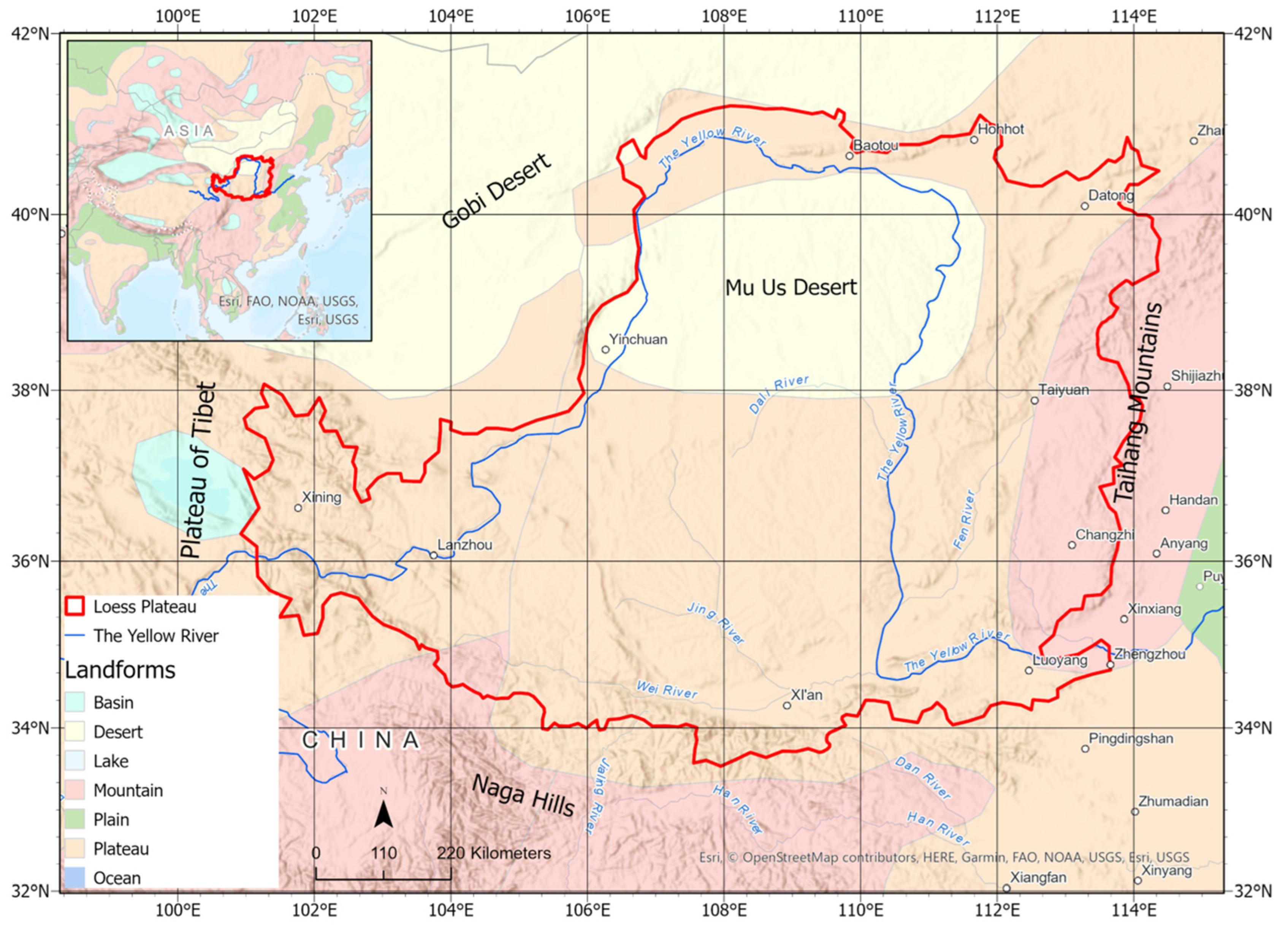
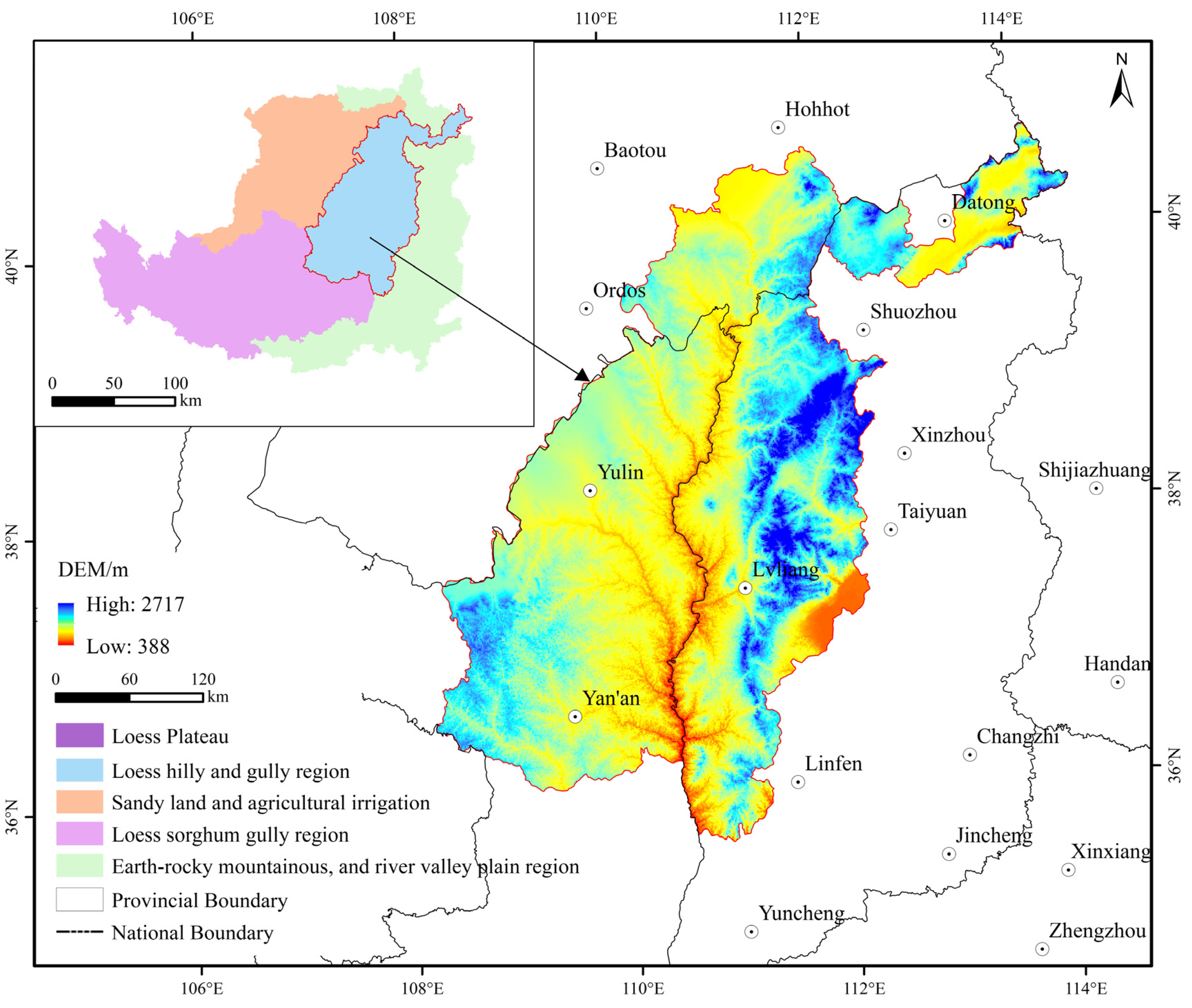
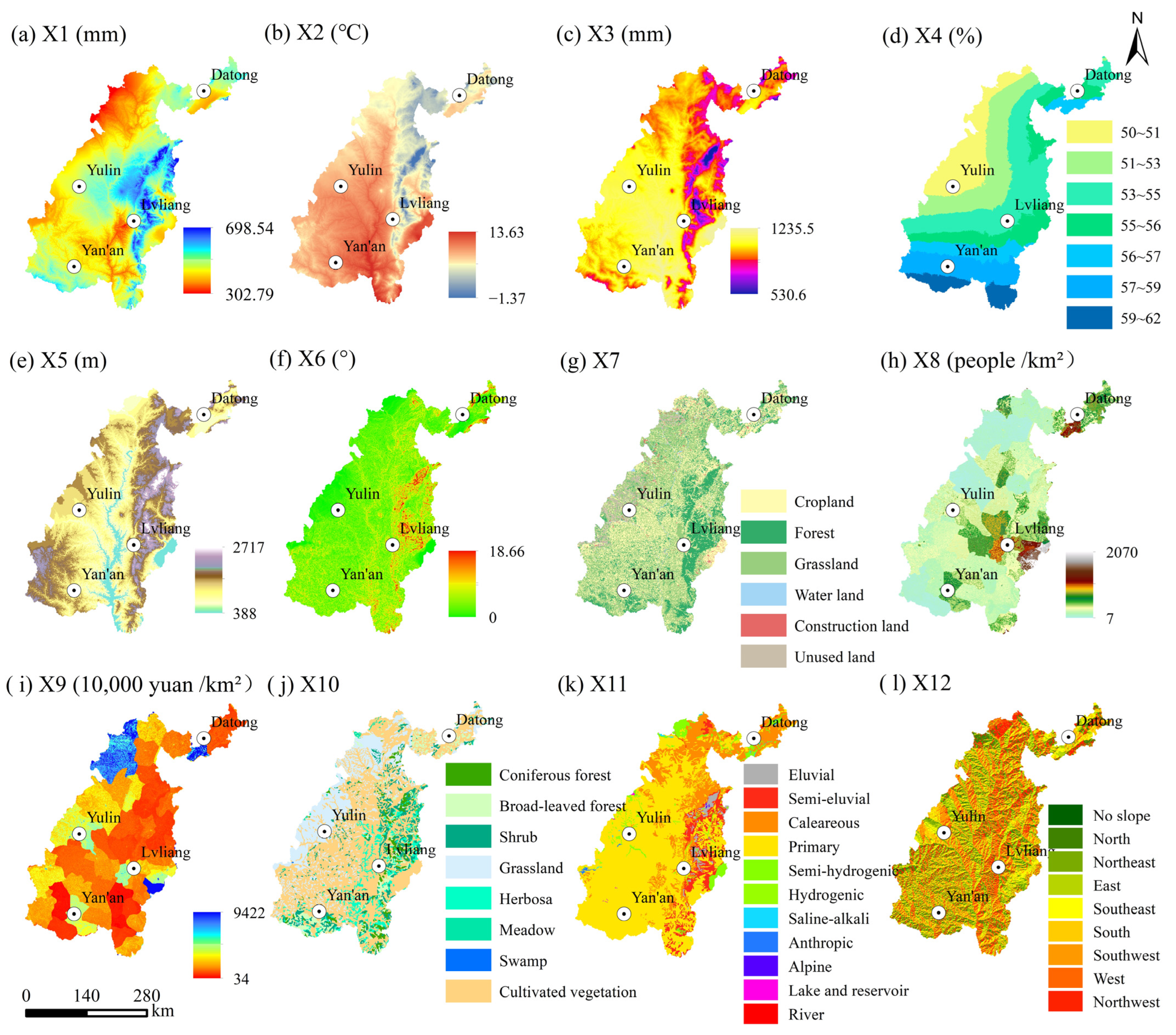
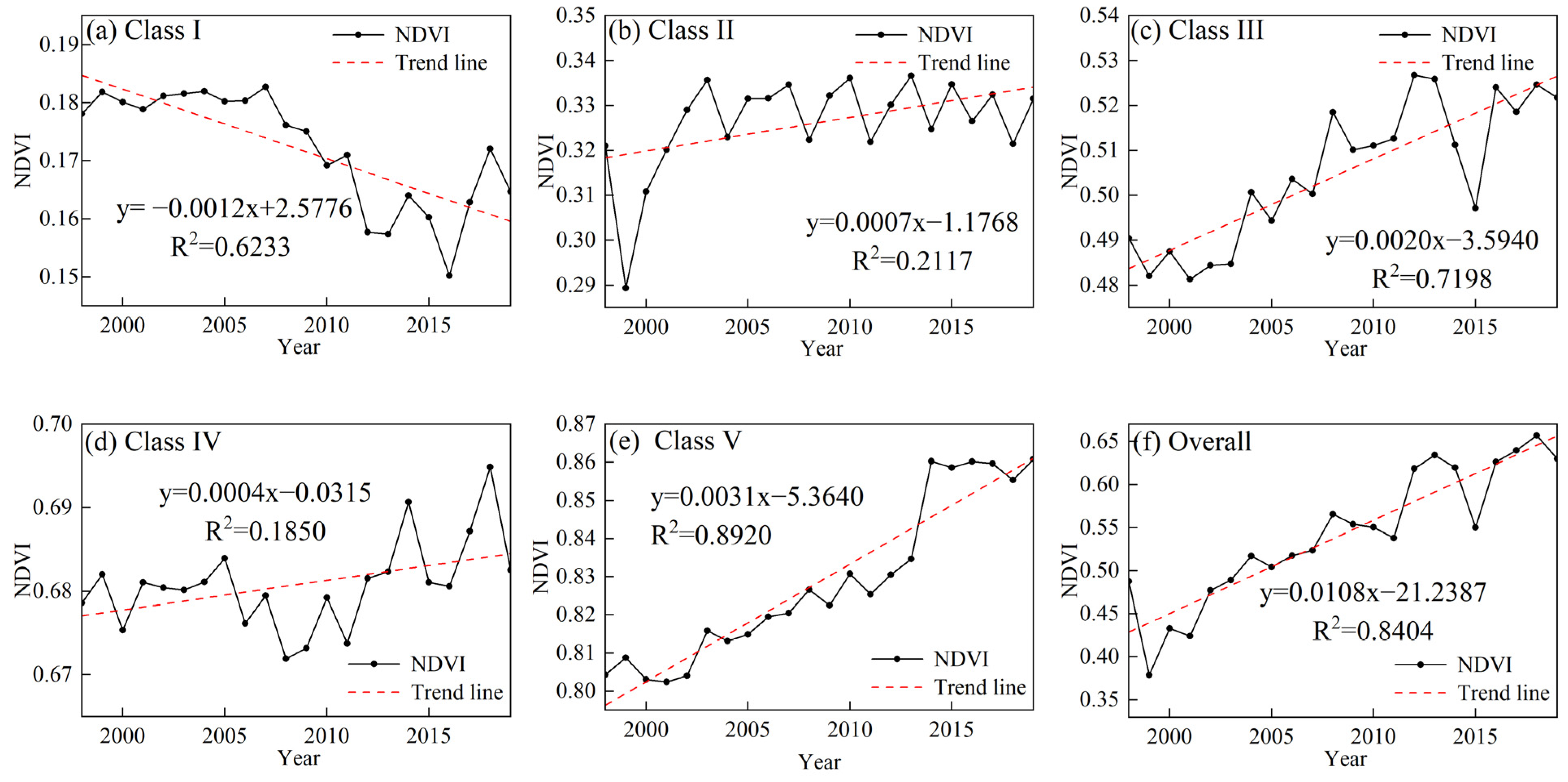
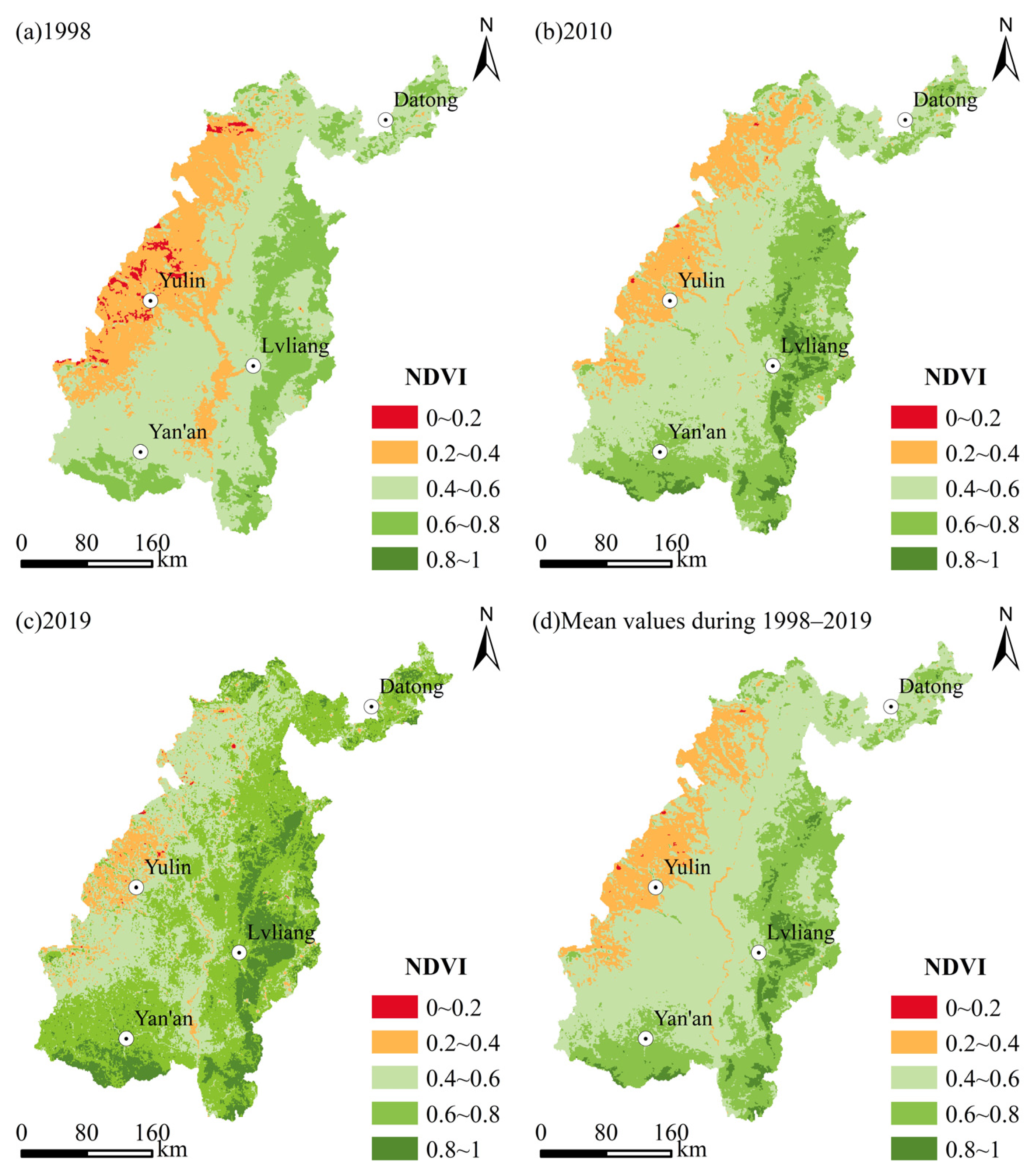

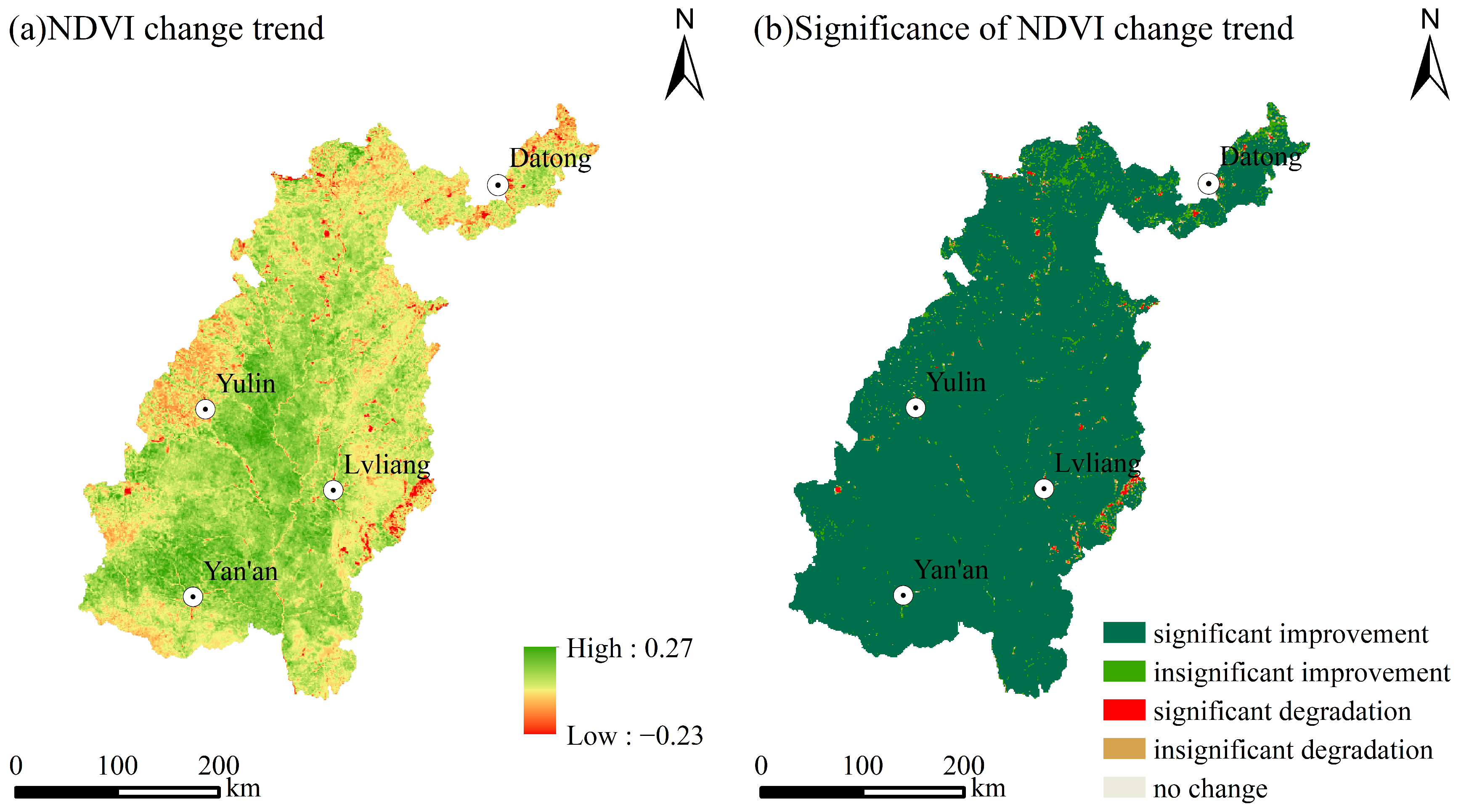
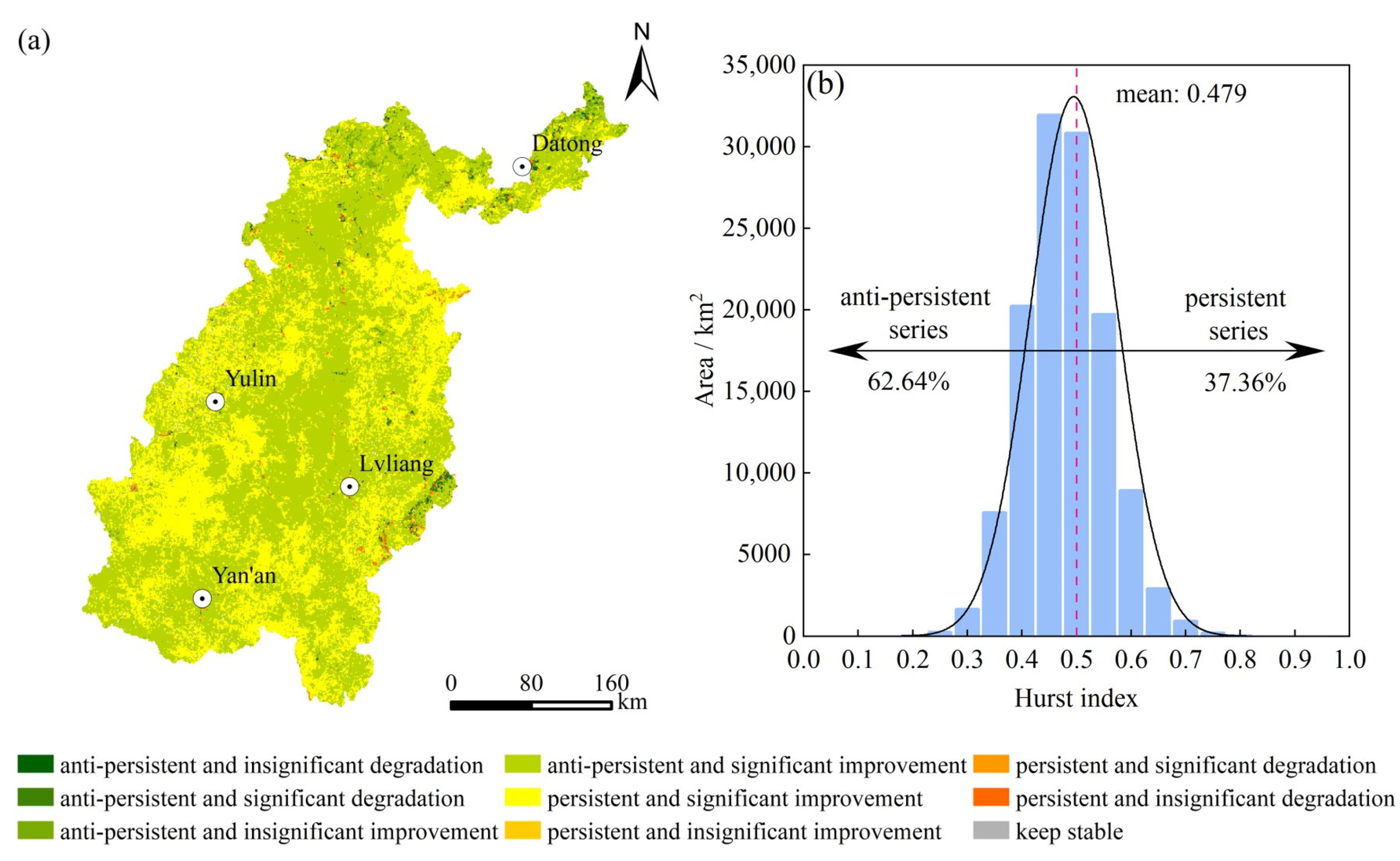


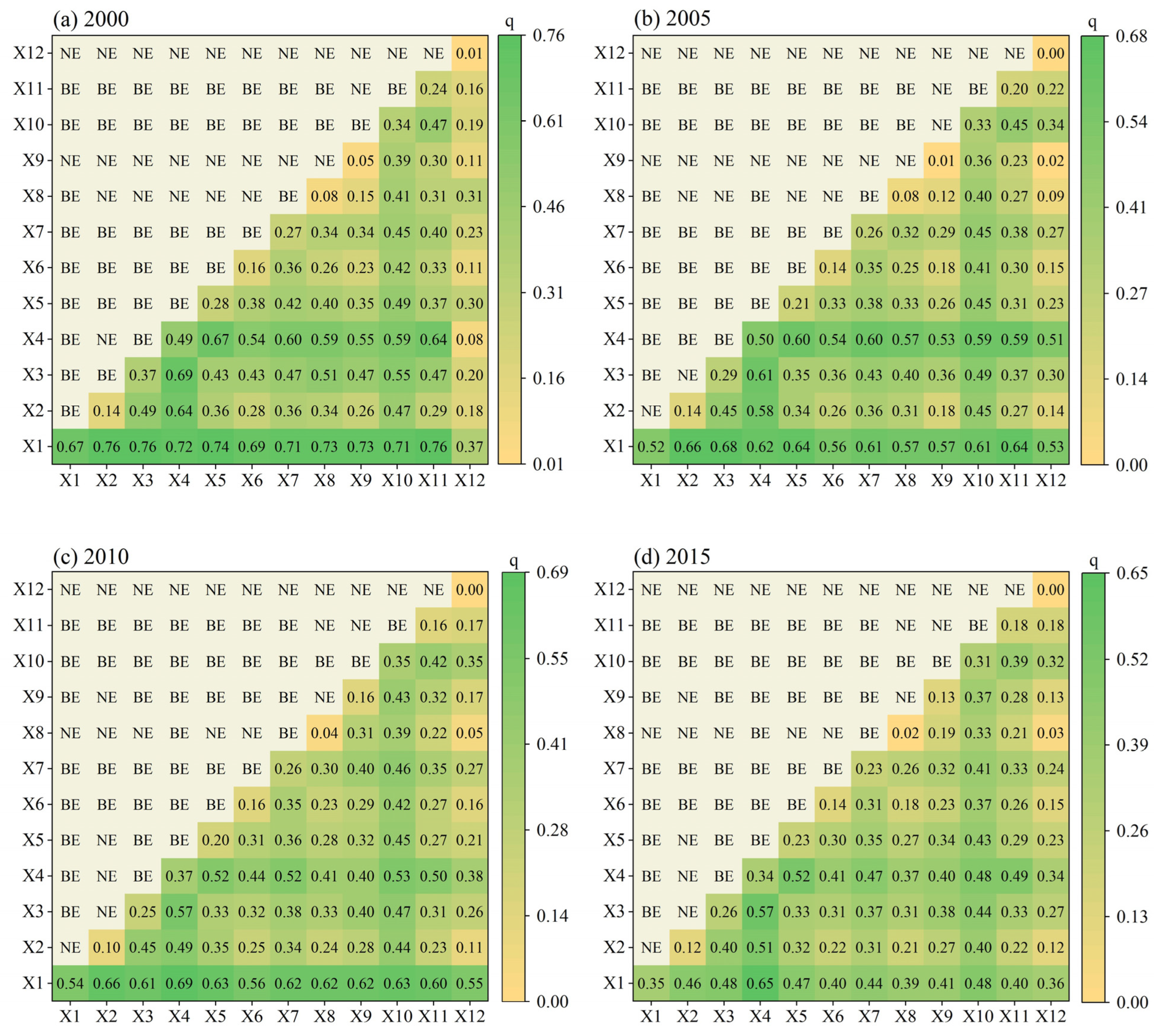
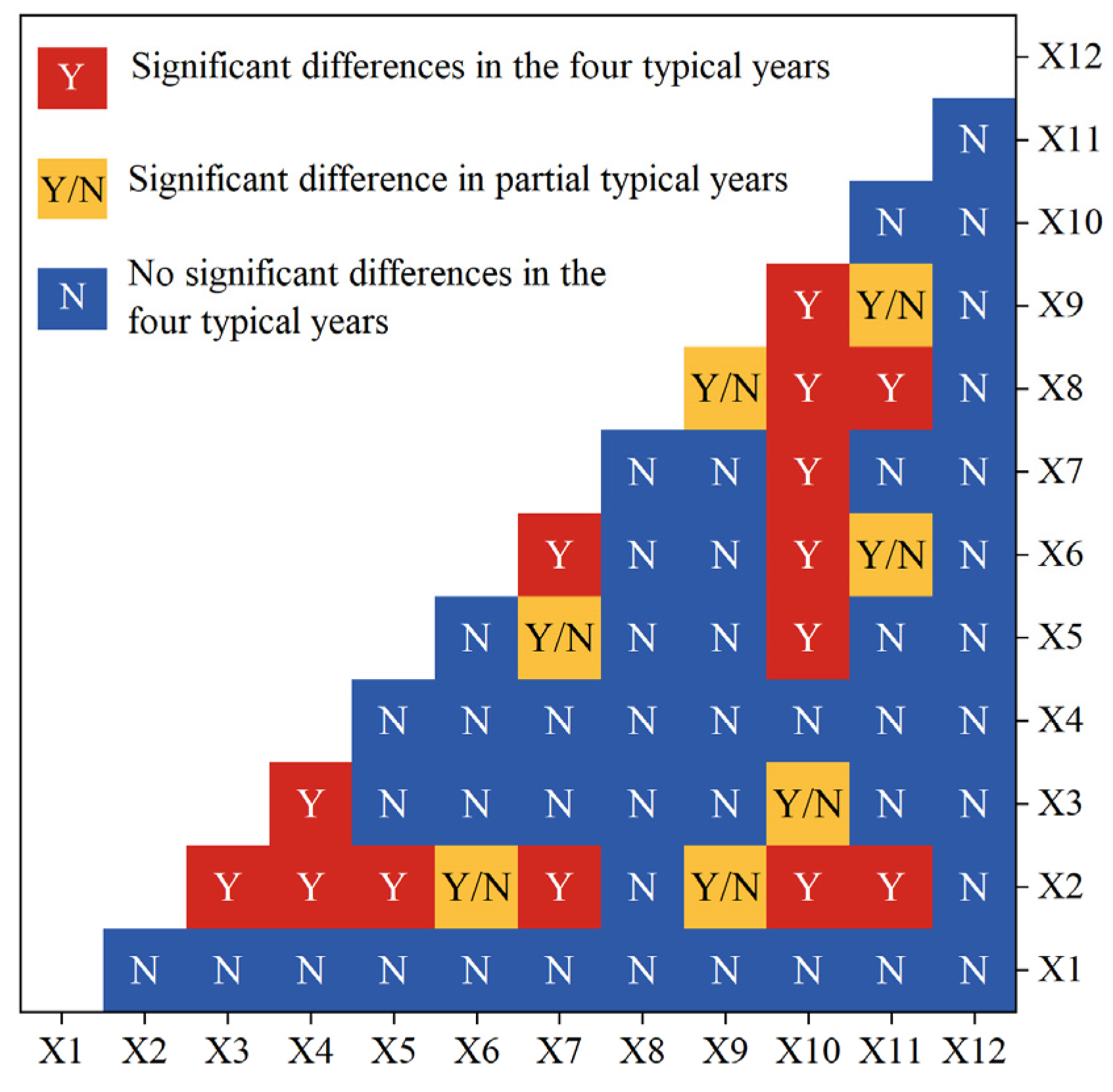
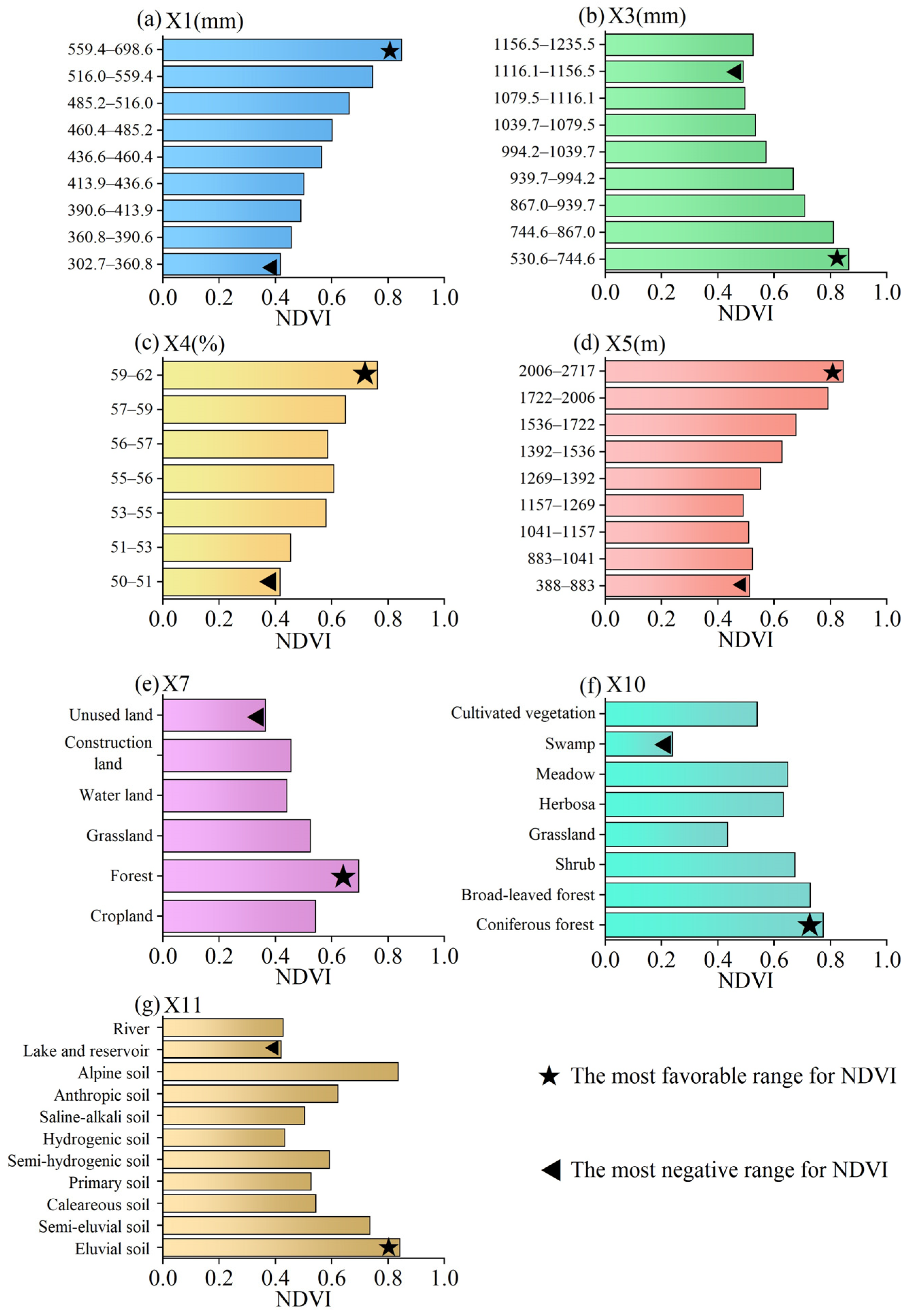
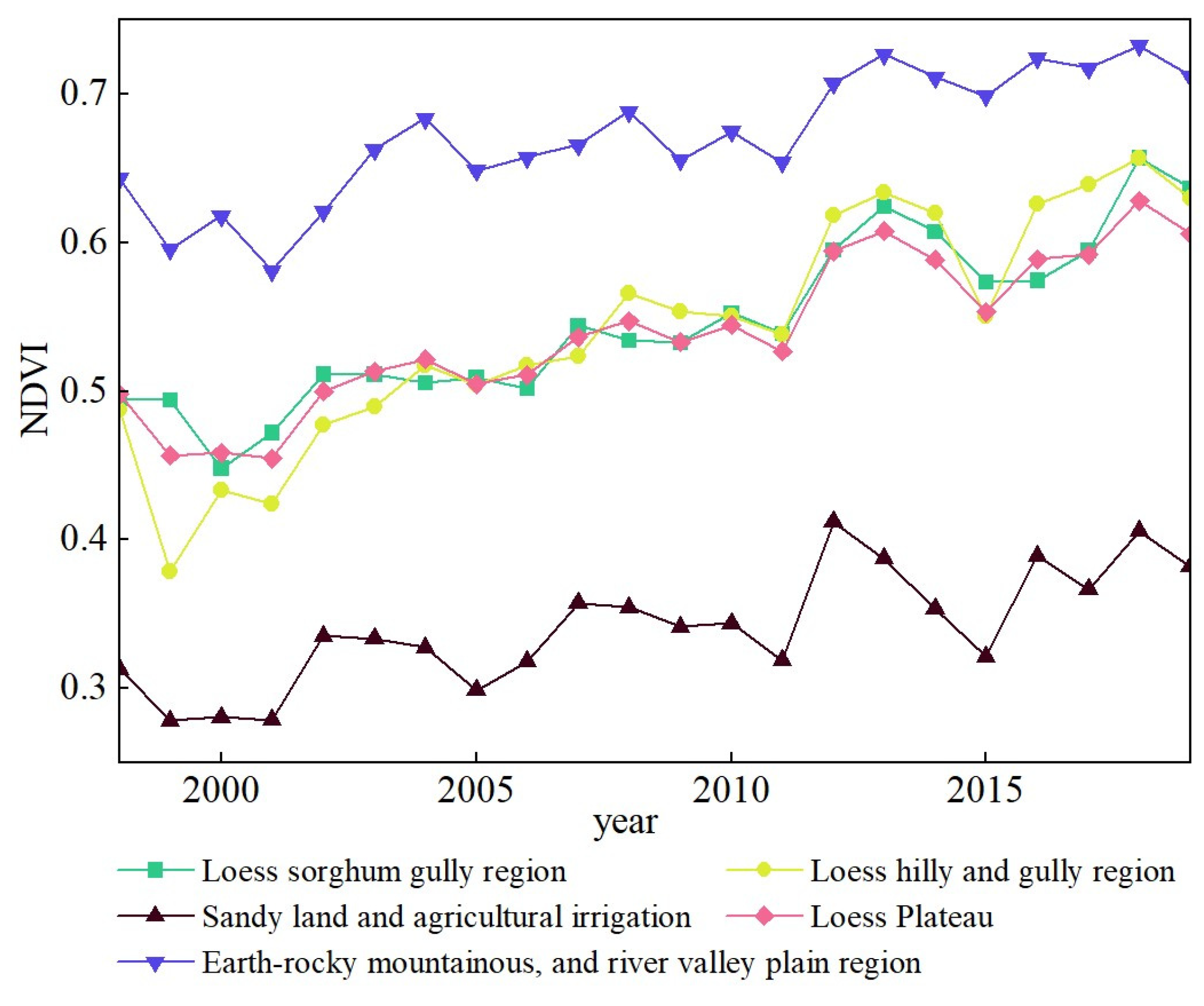
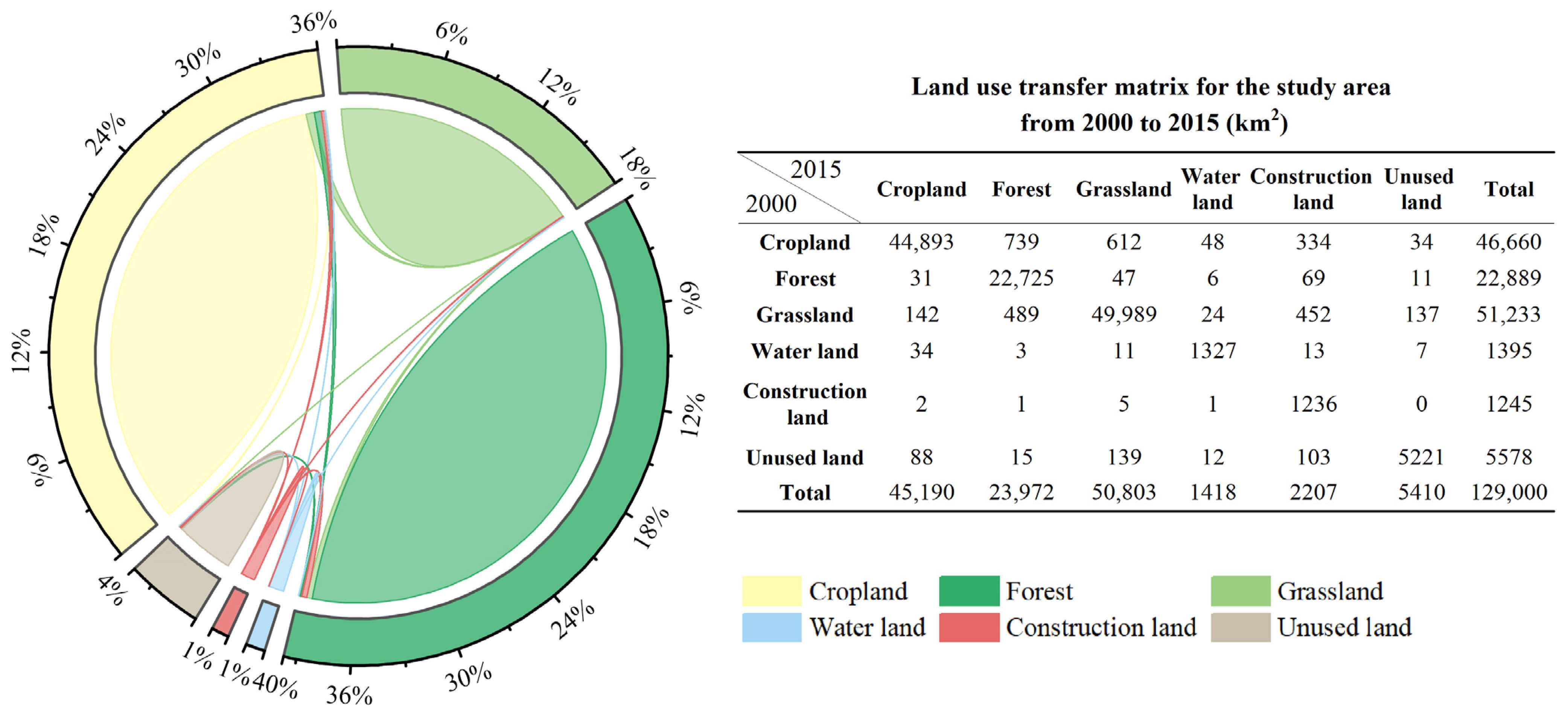
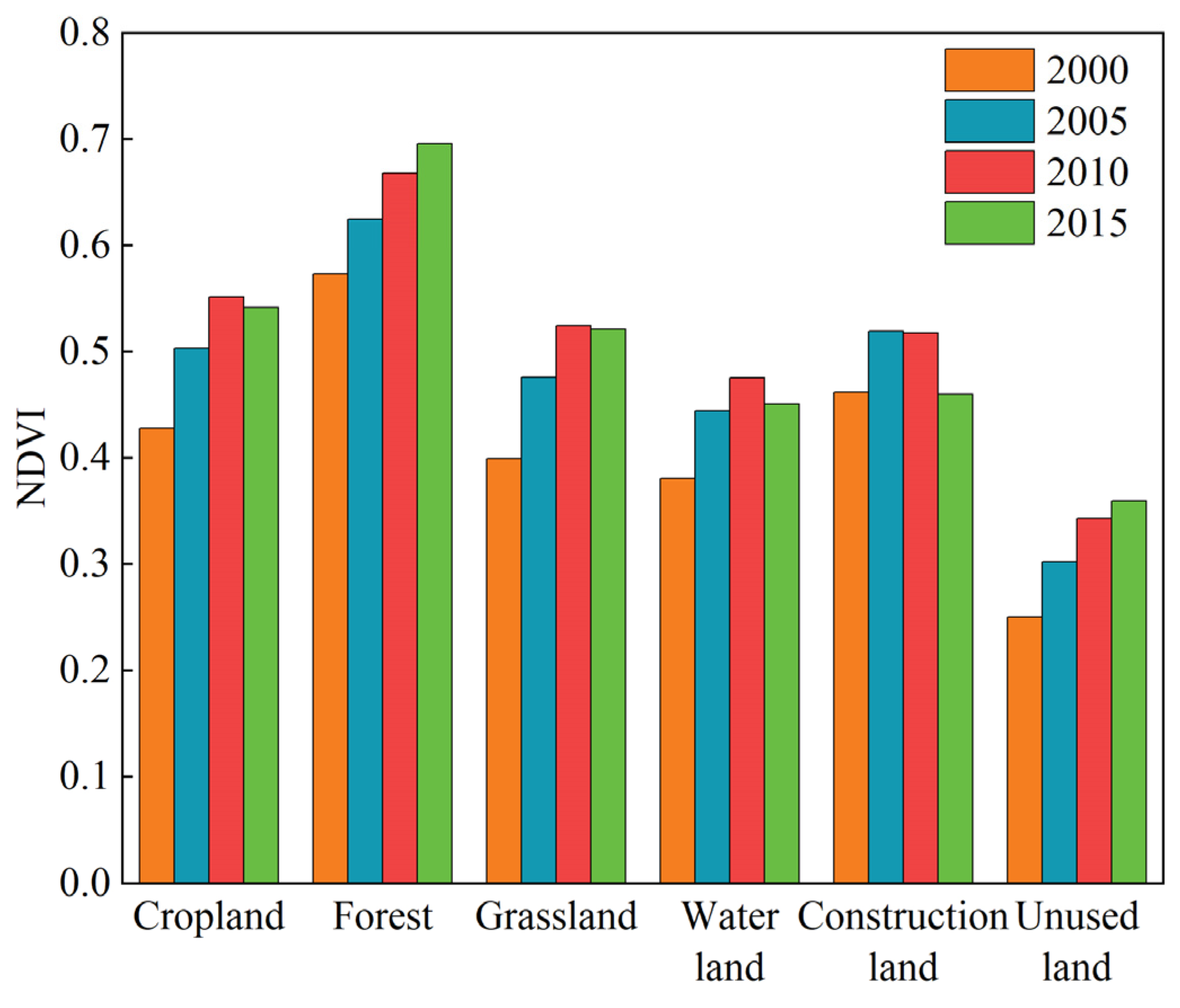
| Code | Detection Factors | Unit | Source |
|---|---|---|---|
| X1 | Annual precipitation | mm | http://data.tpdc.ac.cn (accessed on 20 August 2022) |
| X2 | Mean annual temperature | °C | |
| X3 | Potential evapotranspiration | mm | |
| X4 | Relative humidity | % | http://www.geodata.cn (accessed on 20 August 2022) |
| X5 | Elevation | m | http://www.resdc.cn (accessed on 20 August 2022) |
| X6 | Slope | ° | Extraction from digital elevation model (DEM) |
| X7 | Land use type | / | http://www.resdc.cn (accessed on 20 August 2022) |
| X8 | Population density | people/km2 | |
| X9 | GDP | 10,000 yuan/km2 | |
| X10 | Vegetation type | / | |
| X11 | Soil type | / | |
| X12 | Aspect | / | Extraction from digital elevation model (DEM) |
| β | Z | H | The Description of NDVI Trend |
|---|---|---|---|
| >0 | [1.96, ∞) | (0, 0.5) | Anti-persistent and significant improvement |
| [0, 1.96) | (0, 0.5) | Anti-persistent and insignificant improvement | |
| <0 | [1.96, ∞) | (0, 0.5) | Anti-persistent and significant degradation |
| [0, 1.96) | (0, 0.5) | Anti-persistent and insignificant degradation | |
| >0 | [1.96, ∞) | (0.5, 1) | Persistent and significant improvement |
| [0, 1.96) | (0.5, 1) | Persistent and insignificant improvement | |
| <0 | [1.96, ∞) | (0.5, 1) | Persistent and significant degradation |
| [0, 1.96) | (0.5, 1) | Persistent and insignificant degradation | |
| =0 | — | — | Remaining stable |
| — | — | 0.5 | Uncertainty of change |
| Foundation | Interaction |
|---|---|
| C = A + B | Independent |
| C > A + B | Non-linear enhancement |
| C < D | Non-linear weakening |
| D < C < E | Single-factor non-linear weakening |
| C > E | Dual-factor enhancement |
| Factors | Appropriate Range or Type | Mean NDVI |
|---|---|---|
| annual precipitation (X1) | 559.4–698.6 | 0.848 |
| potential evapotranspiration (X3) | 530.6–744.6 | 0.865 |
| relative humidity (X4) | 59–62 | 0.762 |
| elevation (X5) | 2006–2717 | 0.845 |
| land use type (X7) | forest | 0.696 |
| vegetation type (X10) | coniferous forest | 0.774 |
| soil type (X11) | eluvial soil | 0.842 |
Disclaimer/Publisher’s Note: The statements, opinions and data contained in all publications are solely those of the individual author(s) and contributor(s) and not of MDPI and/or the editor(s). MDPI and/or the editor(s) disclaim responsibility for any injury to people or property resulting from any ideas, methods, instructions or products referred to in the content. |
© 2023 by the authors. Licensee MDPI, Basel, Switzerland. This article is an open access article distributed under the terms and conditions of the Creative Commons Attribution (CC BY) license (https://creativecommons.org/licenses/by/4.0/).
Share and Cite
Jia, Z.; Lei, R.; Liu, Y.; Liu, P.; Wang, Z.; Chang, Y.; Wei, W. Spatial–Temporal Variations and the Driving Factors of Vegetation Coverage in the Loess Hilly and Gully Region of China. Forests 2023, 14, 1238. https://doi.org/10.3390/f14061238
Jia Z, Lei R, Liu Y, Liu P, Wang Z, Chang Y, Wei W. Spatial–Temporal Variations and the Driving Factors of Vegetation Coverage in the Loess Hilly and Gully Region of China. Forests. 2023; 14(6):1238. https://doi.org/10.3390/f14061238
Chicago/Turabian StyleJia, Zhifeng, Rui Lei, Yu Liu, Pengcheng Liu, Zhi Wang, Yingjie Chang, and Wei Wei. 2023. "Spatial–Temporal Variations and the Driving Factors of Vegetation Coverage in the Loess Hilly and Gully Region of China" Forests 14, no. 6: 1238. https://doi.org/10.3390/f14061238






